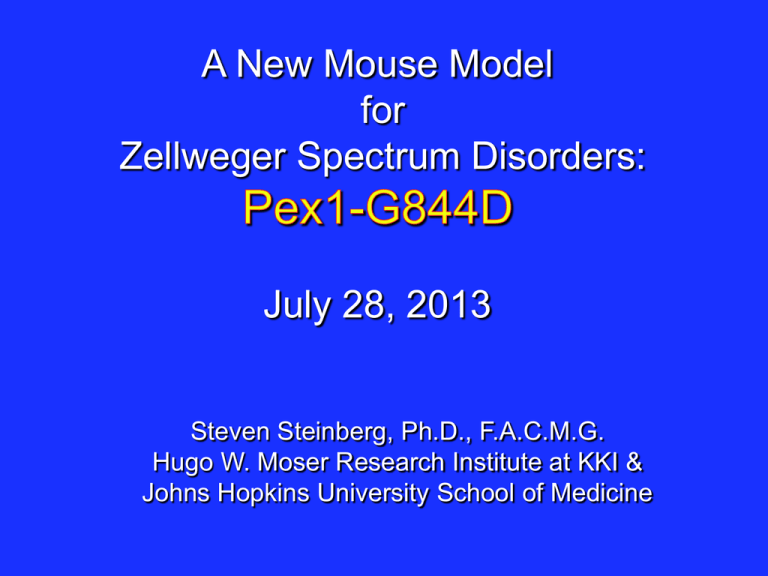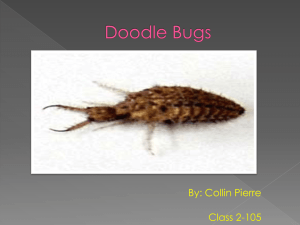
A New Mouse Model
for
Zellweger Spectrum Disorders:
July 28, 2013
Steven Steinberg, Ph.D., F.A.C.M.G.
Hugo W. Moser Research Institute at KKI &
Johns Hopkins University School of Medicine
Zellweger Spectrum Disorders
Zellweger
Syndrome
Most
Severe
Neonatal
Adrenoleukodystrophy
Infantile
Refsum
Disease
Least
Severe
Peroxisome Assembly:
Matrix Protein Receptor Recycling
PEX1 Common Mutations Severity
Zellweger
Syndrome
Neonatal
Adrenoleukodystrophy
Infantile
Refsum
Disease
I700fs &
G843D
G843D &
G843D
Most
Severe
I700fs &
I700fs
Least
Severe
Biochemical: Summary
Why Create a Pex1-G844D Mouse Model?
-A model for testing possible therapeutic
interventions.
e.g.PEX1-G843D is temperature sensitive, indicating it may be responsive to a
chaperone-like molecule
P
thiolase M
37 30
37 30
Pex5
wild type PEX1P, thiolase precursor, 44 kD
M, mature thiolase, 42 kD
-A means of exploring aspects of pathogenesis
not readily explored in humans
e.g. RNA expression profiling of multiple tissues
Construct Design: Pex1-G844D
Construct generated → ES cells electroporation and selection → Blastocyst injection,
implantation & chimera birth → Chimera breeding → Germline G844D Transmission
Matings of Pex1-G844D Heterozygotes
Wt / Wt
Male
Female
Total
9
14
23
G844D / Wt 19
25
44
(25.3%)
(48.4%)
G844D / G844D
13
11
24
TOTAL:
41 (45%)
50 (55%)
91
No evidence of neonatal lethality.
(26.4%)
3 Week Old Littermates
Pex1-G844D / WT
Pex1-G844D / Pex1G844D
Growth Curve
10
9
8
Total Body Weight (grams)
7
6
(n = 14)
Homozygous Male
(n = 13)
Heterozygous Female (n = 26)
Heterozygous Male (n = 22)
Wildtype Female
(n = 17)
Wildtype Male
(n = 10)
Homozygous Female
5
4
3
2
1
0
P7 P8 P9 P10 P11 P12 P13 P14 P15 P16 P17 P18 P19 P20 P21
Days Postnatal (Pn)
Survival
Homozygotes as of June 2013
DIED OF NATURAL CAUSES
Sex
Number
Range (in days)
Median
Male
6
15-147
Female
8
7-45
16
Median
38
LIVING COMFORTABLY
Sex
Number
Range (in days)
Male
20
26-250
106
Female
17
69-258
119
Fertility
Male homozygotes can be fertile
4 Male Homozygote x Female Heterozygote Matings yielded litters
Male homozygote age range at litter birth:
95-110 days
Female heterozygote age range at litter birth:
89-110 days
Number of days pair were together at litter birth:
25-67 days
No evidence that female homozygotes are fertile
5 Male Homozygote x Female Homozygote Matings
Male homozygote age range at end of time together:
95-135 days
Female heterozygote age range at end of time together:95-187 days
Number of days pair were together:
52-92 days
Cultured Fibroblasts
Very Long Chain Fatty Acid Content
Pex1-G844D Alleles
C26:0 µg/mg
C26:0/C22:0
Wildtype
0.023
0.053
Carrier
0.028
0.073
Homozygote
0.465
1.298
Cultured Fibroblasts
Plasmalogen Synthesis
Pex1-G844D Alleles
3H
/ 14C
Wildtype
Carrier
Homozygote
C16DMA
0.69
0.66
4.075
4.097
0.83
C18DMA
1.795
2.041
2.098
0.641
Cultured Fibroblasts
Branched Chain Fatty Acid Metabolism
pmol / 48 hours / mg protein
Pex1-G844D Alleles Phytanic Acid Pristanic Acid
Wildtype
Carrier
Homozygote
582
406 (70%)
119 (20%)
487
509 (105%)
300 (62%)
Cultured Fibroblasts
Catalase Solubility
Pex1-G844D Alleles
% Soluble
Wildtype
11.6%
Carrier
11.8%
Homozygote
83.3%
Immunocytochemistry
Wildtype
Pex1-G844D / Pex1G844D
Chaperone Treatment of Fibroblasts
1.6
1.4
C26:0 / C22:0
1.2
1
0.8
0.6
0.4
0.2
0
141-1 G844D/G844D
141-2 G844D/-
NO DMSO
1% DMSO
141-3 -/-
Chaperone Treatment of Fibroblasts
1
0.9
0.8
C26:0 / C22:0
0.7
0.6
0.5
Regular Media
200mM TMAO
0.4
0.3
0.2
0.1
0
Mouse G844D /
G844D
Mouse G844D /
G844D
Human G843D /
G843D
Human G843D /
G843D
Whole Blood Lipids
C26:0-Lysophosphorylcholine
Pex1-G844D Alleles
% C26:0-LPC
Wildtype (n=42)
0.052 ± 0.016
Carrier
(n=67)
Homozygote (n=17)
0.052 ± 0.018
0.558 ± 0.363
Whole Blood Lipids
Phosphatidylethanolamine Plasmalogens
Pex1-G844D Alleles
Sum of Four (pmoles)
Wildtype (n=42)
5.97 ± 2.34
Carrier
(n=67)
Homozygote (n=17)
5.96 ± 2.83
2.82 ± 2.22
Bile Acid Intermediate
DHCA
Pex1-G844D AllelesPlasma*
Feces**
Wildtype
(n=3,4)
0.063±0.129
1.064±0.378
Carrier
(n=5,4)
0.073±0.052
0.971±0.406
8.7
19.115±14.529
Homozygote (n=1,3)
*pmol per 10µl plasma; **pmol per mg feces
Liver Histology
Wildtype
Pex1-G844D / G844D
Tissue Lipids
Phospholipid Fraction
0.250%
p = 0.007
% C26:0
0.200%
G844D / G844D
0.150%
G844D / G844D
G844D / G844D
WT / WT
G844D / WT
0.100%
G844D / WT
0.050%
0.000%
Spleen
Kidney
Brain
Visual Testing
Electroretinograms
ERG Wave Forms
b-wave
a-wave
Visual Testing
Electroretinograms
250
B-Wave, Photopic
Amplitude (uV)
200
150
Series1
100
Series2
50
0
-0.5
0.0
0.5
1.0
Intensity (log cd-s/m2)
1.5
2.0
Series 1 = Wildtype and Heterozygous Mice, n=4
Series 2 = Pex1-G844D Homozygous Mice, n=4
Visual Testing
Retinal Histology: Cone Photoreceptor Staining
Homozygote, 28 days
Heterozygote, 28 days
inl =
inner nuclear
layer
onl =
outer nuclear
layer
is =
inner segment
of photoreceptor
layer
os =
outer segment
of photoreceptor
layer
Homozygote, 147 days
Wildtype, 149 days
Pex1-G844D Mouse Model Summary
-Growth stunted
-Males can be fertile, but not female
-Biochemical profile is comparable to human
patients homozygous for PEX1-G843D
-Compelling evidence of retinal pathology and
dysfunction comparable to human patients
-Preliminary evidence of liver dysfunction that
is likely comparable to human patients
Pex1-G844D Mouse Future Plans
-Treatment with compounds identified by drug
screening using a cell model system to test for
in vivo efficacy
-Behavioral studies
-Generate Pex1 knock out and generate Pex1-KO /
Pex1-G844D compound heterozygotes and tissue
specific knock outs
Collaborators
-Shandi Hiebler
-Ann Moser
-Anita Liu
-Paul Watkins
-Dominik Reisinger
-Outside KKI / JHU
-Jean Bennett
-Nancy Braverman
-Gerald Raymond
-Joseph Hacia
-Michael Paine
-Phyllis Faust
-Amanda Lauer
-Tomohiro Masuda
-Don Zack
Sponsored by the Park-Hopkins
and Woodbury research funds donations
at Kennedy Krieger Institute








